小升初英语总复习课件:第三章 句型(52张ppt)
文档属性
| 名称 | 小升初英语总复习课件:第三章 句型(52张ppt) | 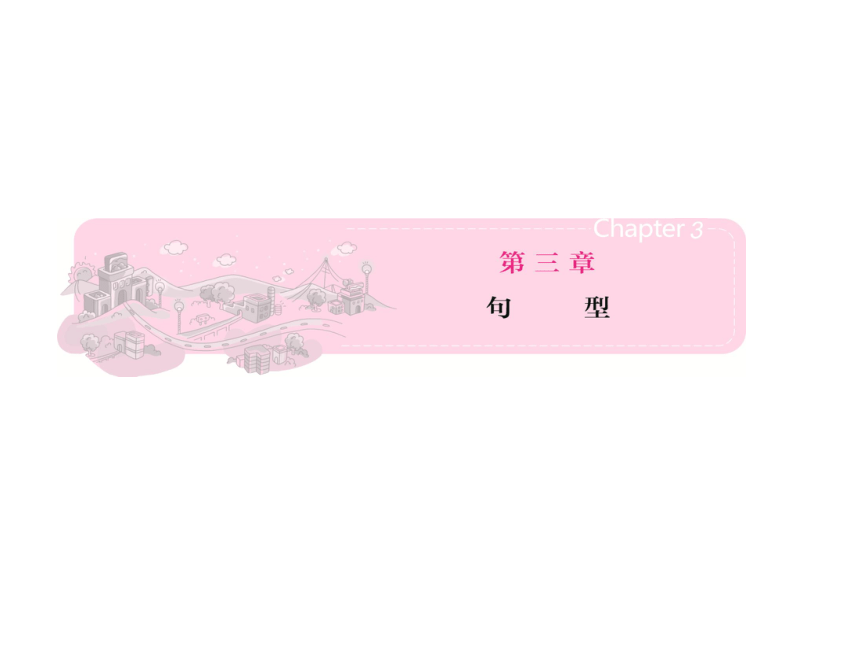 | |
| 格式 | ppt | ||
| 文件大小 | 3.1MB | ||
| 资源类型 | 教案 | ||
| 版本资源 | 人教版(PEP) | ||
| 科目 | 英语 | ||
| 更新时间 | 2021-03-02 17:54:15 | ||
图片预览

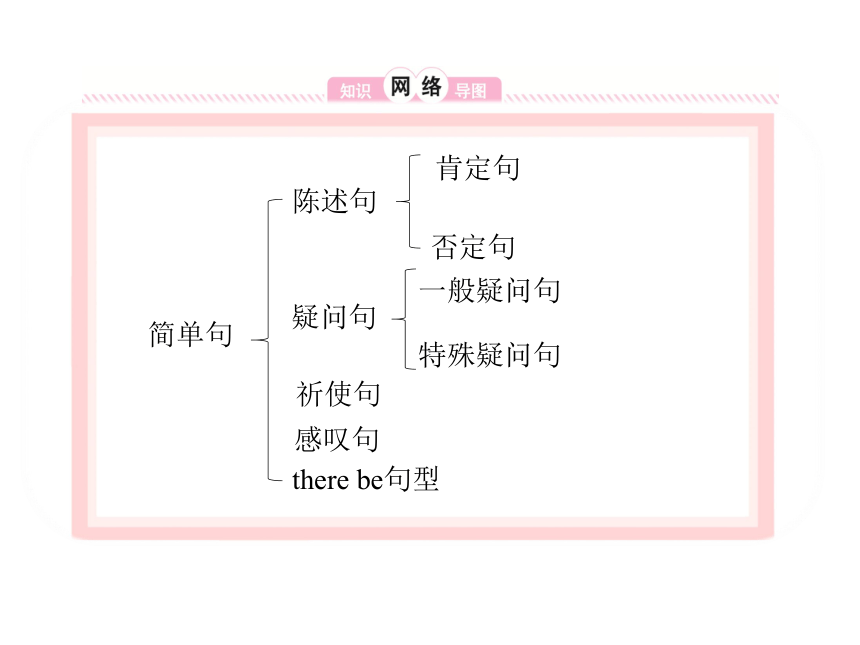
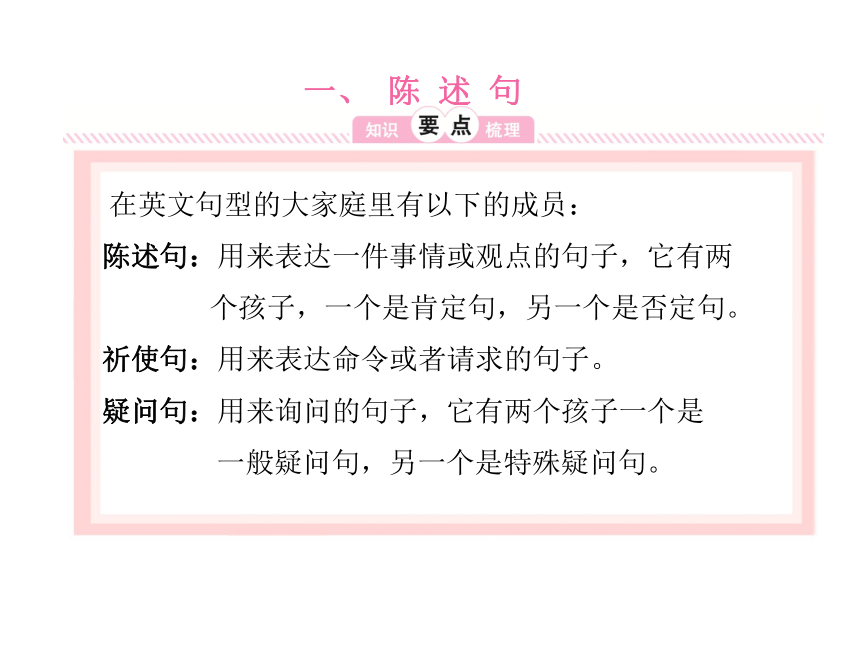
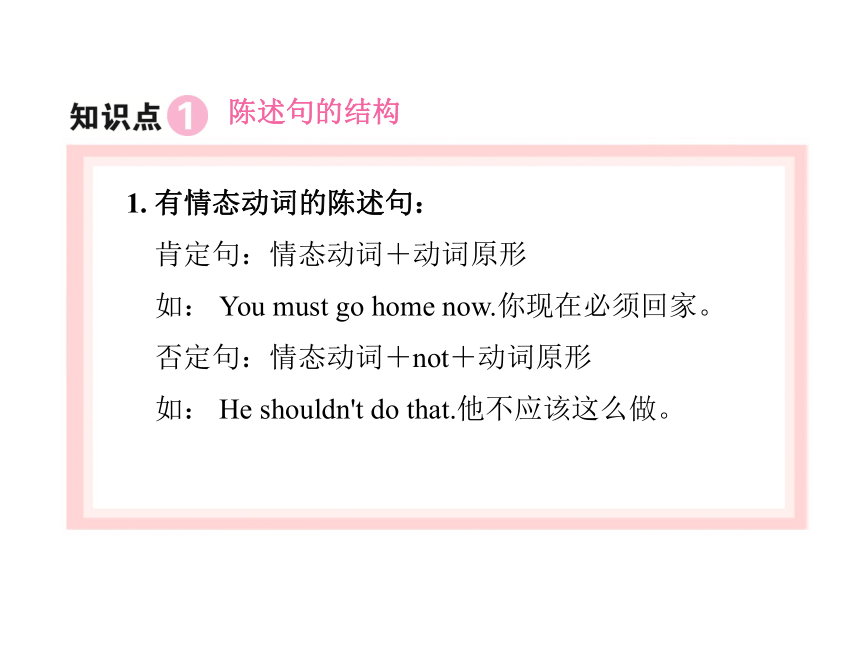
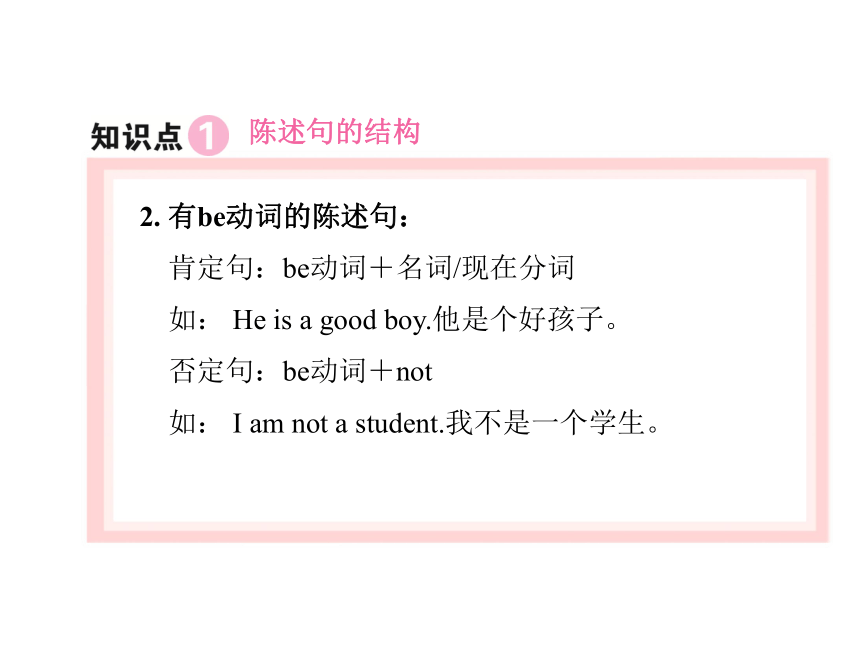
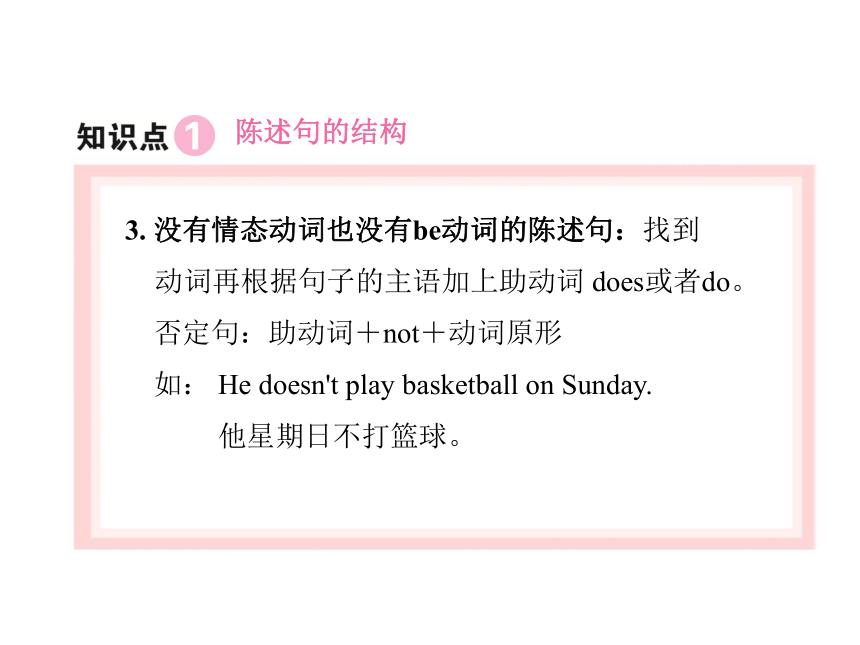
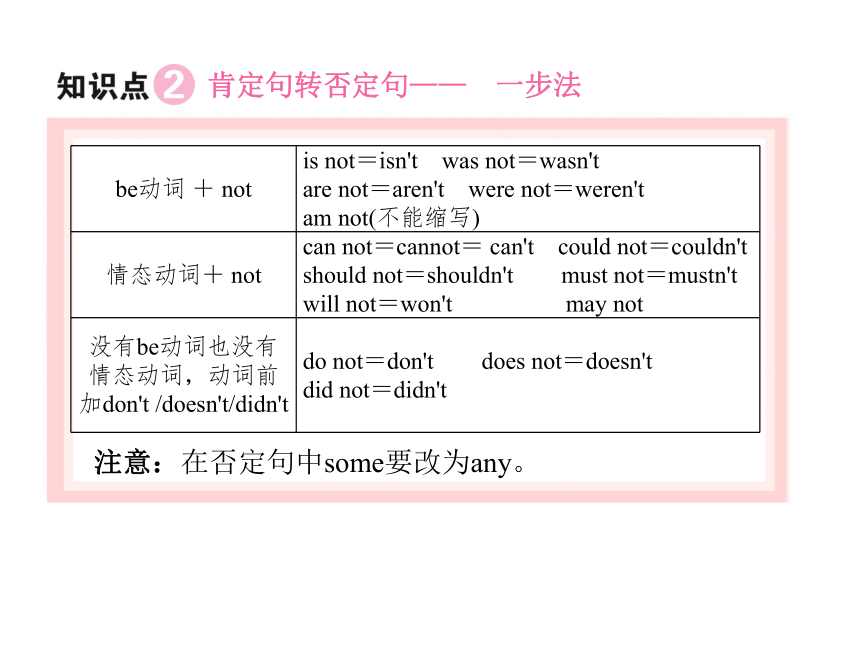
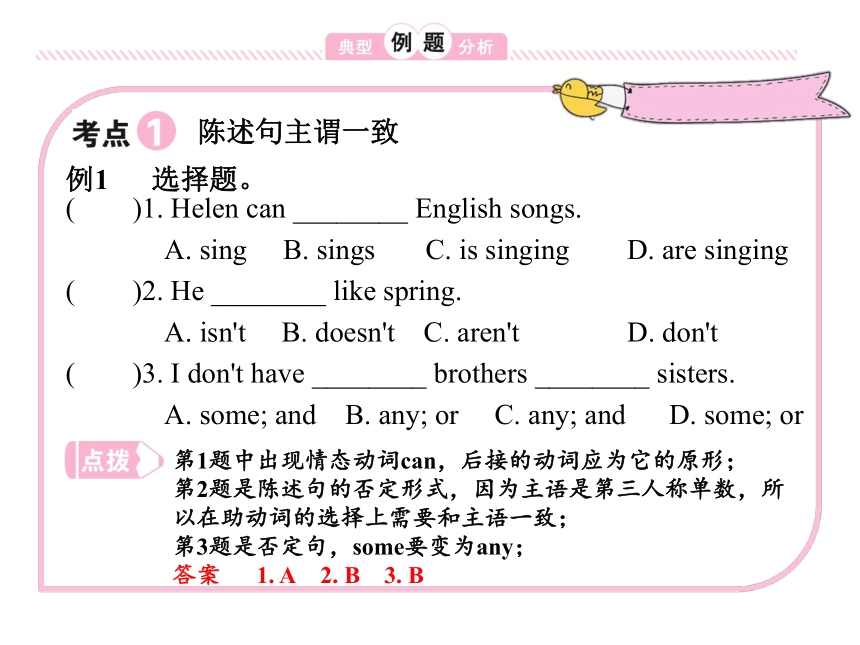
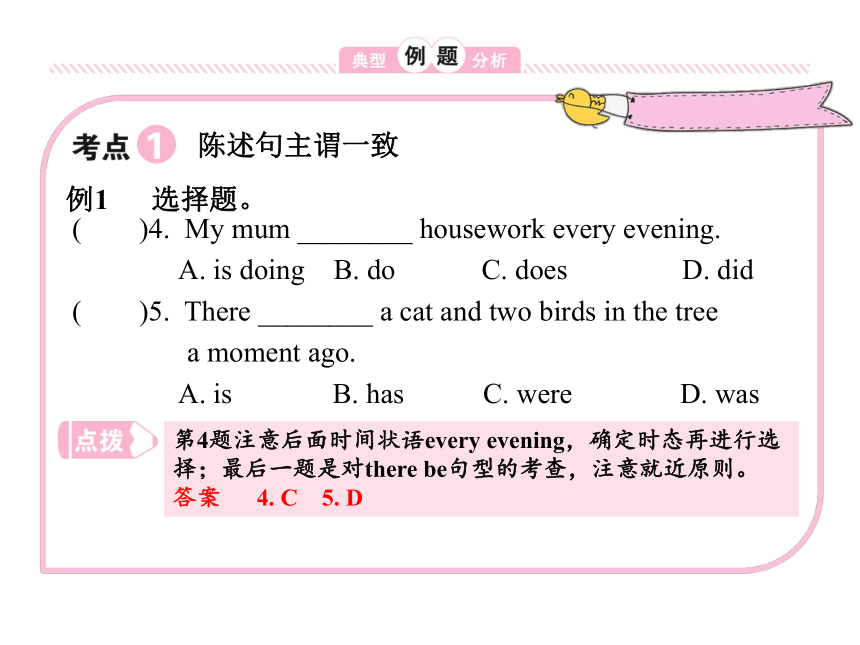
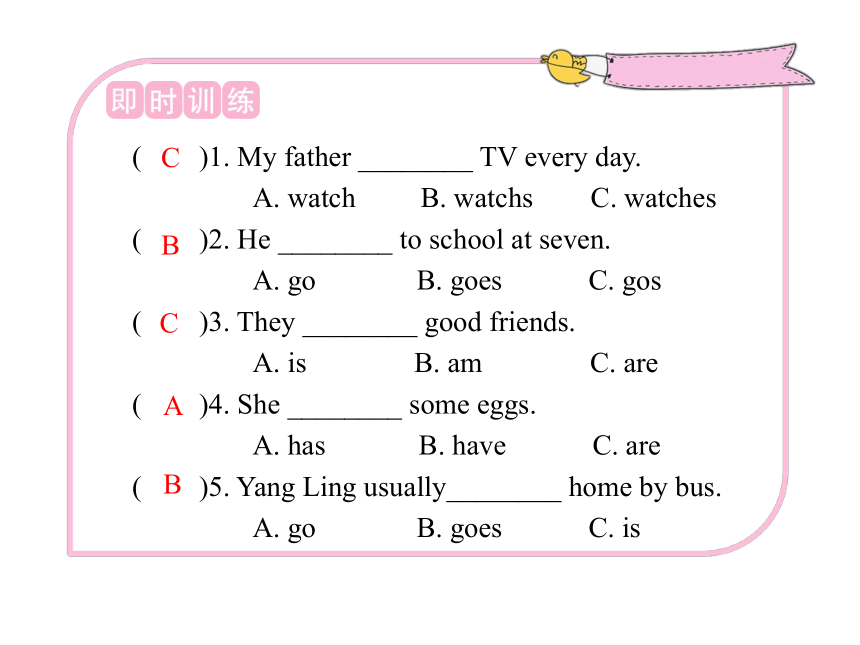
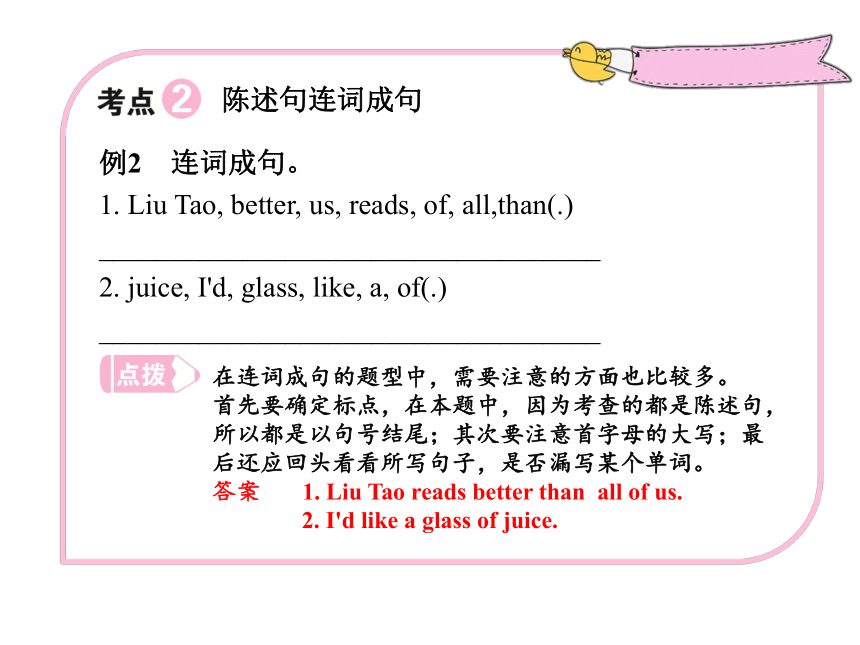
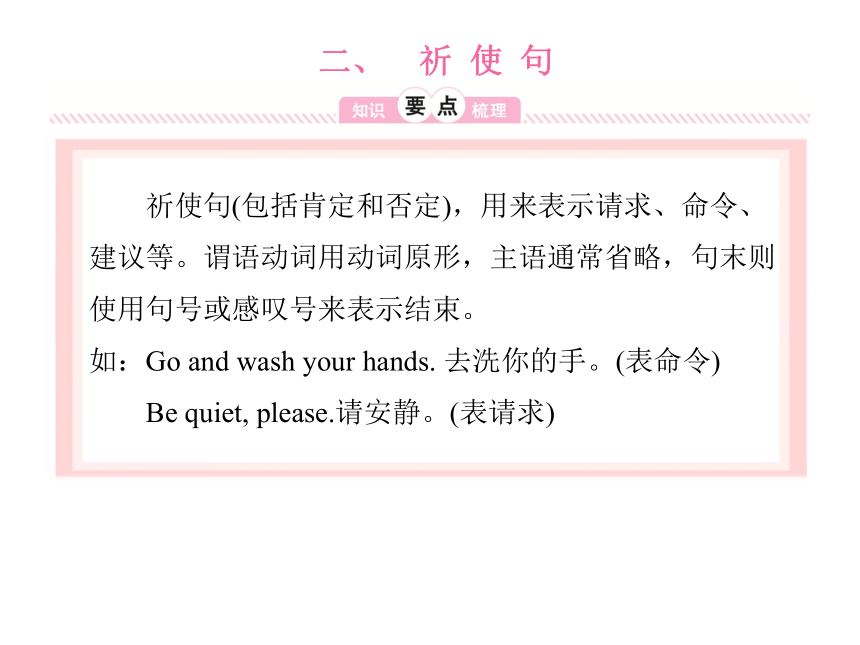
文档简介
简单句
陈述句
肯定句
否定句
there be句型
一般疑问句
特殊疑问句
疑问句
祈使句
感叹句
一、 陈 述 句
在英文句型的大家庭里有以下的成员:
陈述句:用来表达一件事情或观点的句子,它有两
个孩子,一个是肯定句,另一个是否定句。
祈使句:用来表达命令或者请求的句子。
疑问句:用来询问的句子,它有两个孩子一个是
一般疑问句,另一个是特殊疑问句。
陈述句的结构
1. 有情态动词的陈述句:
肯定句:情态动词+动词原形
如: You must go home now.你现在必须回家。
否定句:情态动词+not+动词原形
如: He shouldn't do that.他不应该这么做。
陈述句的结构
2. 有be动词的陈述句:
肯定句:be动词+名词/现在分词
如: He is a good boy.他是个好孩子。
否定句:be动词+not
如: I am not a student.我不是一个学生。
陈述句的结构
3. 没有情态动词也没有be动词的陈述句:找到
动词再根据句子的主语加上助动词 does或者do。
否定句:助动词+not+动词原形
如: He doesn't play basketball on Sunday.
他星期日不打篮球。
肯定句转否定句—— 一步法
be动词 + not
is not=isn't was not=wasn't
are not=aren't were not=weren't
am not(不能缩写)
情态动词+ not
can not=cannot= can't could not=couldn't should not=shouldn't must not=mustn't
will not=won't may not
没有be动词也没有情态动词,动词前加don't /doesn't/didn't
do not=don't does not=doesn't
did not=didn't
注意:在否定句中some要改为any。
陈述句主谓一致
例1 选择题。
( )1. Helen can ________ English songs.
A. sing B. sings C. is singing D. are singing
( )2. He ________ like spring.
A. isn't B. doesn't C. aren't D. don't
( )3. I don't have ________ brothers ________ sisters.
A. some; and B. any; or C. any; and D. some; or
第1题中出现情态动词can,后接的动词应为它的原形;
第2题是陈述句的否定形式,因为主语是第三人称单数,所以在助动词的选择上需要和主语一致;
第3题是否定句,some要变为any;
答案 1. A 2. B 3. B
陈述句主谓一致
例1 选择题。
( )4. My mum ________ housework every evening.
A. is doing B. do C. does D. did
( )5. There ________ a cat and two birds in the tree
a moment ago.
A. is B. has C. were D. was
第4题注意后面时间状语every evening,确定时态再进行选择;最后一题是对there be句型的考查,注意就近原则。
答案 4. C 5. D
( )1. My father ________ TV every day.
A. watch B. watchs C. watches
( )2. He ________ to school at seven.
A. go B. goes C. gos
( )3. They ________ good friends.
A. is B. am C. are
( )4. She ________ some eggs.
A. has B. have C. are
( )5. Yang Ling usually________ home by bus.
A. go B. goes C. is
C
B
C
A
B
陈述句连词成句
例2 连词成句。
1. Liu Tao, better, us, reads, of, all,than(.)
___________________________________
2. juice, I'd, glass, like, a, of(.)
___________________________________
在连词成句的题型中,需要注意的方面也比较多。
首先要确定标点,在本题中,因为考查的都是陈述句,所以都是以句号结尾;其次要注意首字母的大写;最后还应回头看看所写句子,是否漏写某个单词。
答案 1. Liu Tao reads better than all of us.
2. I'd like a glass of juice.
二、 祈 使 句
祈使句(包括肯定和否定),用来表示请求、命令、建议等。谓语动词用动词原形,主语通常省略,句末则使用句号或感叹号来表示结束。
如:Go and wash your hands. 去洗你的手。(表命令)
Be quiet, please.请安静。(表请求)
肯定祈使句
1.以动词原形开头。如:Turn on the TV, please.
2.以let 开头。如:Let me help you. Let's have a rest.
1.若主语是第二人称,否定祈使句可直接在句首加don't构成。
如:Don't talk to each other in the classroom.
/ Don't be late again.
2.以No开头。如:No Smoking! No photos!
否定祈使句
祈使句的各种形式
例 1 用所给动词的适当形式填空。
1. Let him ________ (help) you.
2. ________ (open) the window, please.
3. Don't ________ (park) here.
4. No ________ (smoke) in the library.
5. Don't ______ (speak) loudly in the reading room.
祈使句中没有主语,有时候一个单词或者短语也可作为祈使句,比如:No swimming! Danger! 在第4题中就出现了这样的例子;第1题是以let开头的祈使句;第2、3、5题分别是祈使句的肯定和否定形式的典型。
答案 1. help 2. Open 3. park 4. smoking
5. speak
用括号内所给动词的适当形式填空。
1. It's an important meeting. ______________(not, be)late.
2. ____________(not, make) any noise! Your mother is sleeping.
3. ____________(not, talk) and ___________(be) quiet.
4. Please ___________ (read) aloud.
5. ____________(look) out! A car is coming.
Don’t be
Don’t make
Don’t talk
be
read
Look
三、 感 叹 句
感叹句是表示喜、怒、哀、乐等强烈感情的句子。感叹句多以how和what开头。句末用感叹号。
how引导的感叹句
1. How+形容词+主语+谓语!
例:How bright the moon is! 月亮多么明亮呀!
2. How+副词+主语+谓语!
例:How hard he studies! 他学习多么刻苦啊!
what引导的感叹句
1.What+(a/an)+形容词+单数可数名词+主语+谓 语! What作主语修饰名词,单数名词前加冠词a或an。
如: What a lovely girl she is!
她是一个多么可爱的女孩!
2. What+形容词+复数名词或不可数名词+主语+谓语! 如: What bad news!多么糟的消息!
例1 选择题。
( )1. ________ clever girl she is!
A. What a B. How C. How a
( )2. What ________ it is!
A. a delicious food B. delicious food C. delicious foods
( )3. ________ beautiful the present is!
A. What B. How C. What a
感叹词
感叹句在小学阶段要求并不多,主要是区别what和how的用法。wha修饰名词,how后面加形容词。还需注意冠词a和an的用法,第2题中还要看到可数名词和不可数名词的区别。
答案 1. A 2. B 3. B
( )1.________ a clever boy he is!
A. What B. How C. What's
( )2.________ she dances!
A. How good B. How well C. What well
( )3.________ quiet the park is!
A. What a B. How C. How a
A
B
B
四、 疑 问 句
疑问句用来提出问题,一般有以下几种:
一般疑问句是以“be” 动词、助动词或者情态动词“can”开头的疑问句,用“Yes”或者“No”来作答。如:
(1)—Is this your bedroom? ——这是你的卧室吗?
—Yes, it is.——是的。
(2)—Are these / those / they cucumbers ?
——这些 / 那些/它们是黄瓜吗?
—Yes, they are. / No, they aren't.——是的。/ 不是的。
一般疑问句
(3)—Is there a river in the park? ——公园里有一条小河吗?
—Yes, there is. / No, there isn't.——有。/ 没有。
(4)—Can I wear my new shirt today?
——我今天可以穿新衬衫吗?
—Yes, you can. / No, you can't.——可以。/ 不可以。
(5)—Does your pen pal live in Shanghai?
——你的笔友住在上海吗?
—No, he doesn't. He lives in Beijing.——不,他住在北京。
(6)—Did you read books yesterday?——你昨天读书了吗?
—Yes, I did. / No, I didn't.——读了。/ 没读。
一般疑问句
肯定句改为一般疑问句的方法
有be动词
He is a doctor.→Is he a doctor?
把be动词放在句首,剩下的照抄,(some改成any,my改成your等)句号改成问号
有情态动词
My father can dance very well.
→Can your father dance very well?
把can, shall, will等放到句首,剩下的照抄,(some改成any,my改成your等)句号改成问号
没有be动词
或情态动词
My mother likes to swim in the river.
→Does your mother like to swim in the river?
句首请助动词Do/Does/Did帮忙,动词变原形,剩下的照抄,(some改成any,my改成your等)句号改成问号
特殊疑问句
特殊疑问句:以特殊疑问词开头的疑问句叫特殊疑问句。
问姓名
What is your name? What is my/his/her/its name?
问年龄
How old are you? How old is he/she/it?
问颜色
What color is it?
问形状
What shape is it?
问数量
How many+可数名词
How much+不可数名词
问价钱
How much is it?
问时间或日期
What day is it today? What time is it now? When is it?
What is the date today? =What date is it today?
问方位或地方
Where do you live? Where are you from? Where are your keys? Excuse me, where is the library?
问想吃的东西
What would you like for breakfast/lunch/dinner?
What's for breakfast/lunch/dinner?
问天气
How's the weather today? What is the weather like today?
问状况
How are you? What's the matter? How do you feel?
问职业、身份或人物
What's your job?=What do you do?
What do you do for living?=What are you?
Who is he/she/it? Who are you/they?
特殊疑问句
问兴趣、喜好
What's your favorite…?
=What/Which…do you like best?
What's your hobby?
问通常做的事情(经常发生的事情用一般现在时)
What do you usually do on weekdays?
When do you usually get up?
问正在做的事情(正在发生的事情用现在进行时)
What are you doing? What is the tiger doing?
问将要做的事情(将要发生的事情用一般将来时)
What is she going to do? What will you do?
Where are you going tomorrow?
问曾经发生过的事情(过去发生过的事情用一般过去时)
What did you do last night? Where was he the day before yesterday?
When did he come back? How did she make it?
特殊疑问句
选择疑问句
选择疑问句是说话人提出两种或两种以上的情况,询问对方选择哪一种。选择疑问中的选项用or连接,语调是第一种选择用升调,最后一种选择用降调。回答时选择一种,不可用yes或no作答。
(1)—Whose bag is heavier,yours or mine?
——谁的包更重,你的还是我的?
—Mine is, I think. ——我的重些,我想。
(2)—Is the apple big or small?——这个苹果是大还是小?
—It is big. ——它是大的。
(1)—What's in the classroom?——教室里有什么?
—A board, six lights, three fans, many desks and chairs.
——一块黑板、六盏灯,三个电扇和许多桌椅。
(2)What about you? / How about you? 你呢?
(3)—Whose is it? ——它是谁的?
—It's mine / yours / his / hers.
——是我的 / 你的 / 他的 / 她的。
其他特殊疑问句
其他特殊疑问句
(4)—What can you do?——你会做什么?
—I'm helpful. I can sweep the floor and do the dishes.
——我很能干。我会扫地、洗盘子。
(5)—What's your bedroom like?——你的卧室是什么样儿的?
—There is a big closet and a new mirror.
There are blue curtains.
——卧室里有一个大衣橱和一面新镜子。
还有蓝色的窗帘。
1. 在一般疑问句的基础上,句首添加一个疑问词即可,可根据画线部分确定是什么疑问词。如问时间用when或what time,问地点用where,问价钱用how much,问年龄用how old,问原因用why,问“做什么事”用what do/does/did等。
肯定句改特殊疑问句的方法——三步法
肯定句改特殊疑问句的方法——三步法
2. 接着找be动词或can,shall, will等放在疑问词后面,若没有则请助动词do/does/did帮忙,写在疑问词后面,how many除外,必须先写物品,再写be动词等。
3. 画线部分去掉后剩下的内容照抄。some 改成any,my改成your等,句点改成问号。
特殊疑问句中疑问代词的使用:
What
什么
What is your name?你叫什么名字?
What color is it?它是什么颜色?
What shape is it?它是什么形状?
What day is it today?今天是星期几?
What is the date today?今天是几月几日?
What do you usually eat for breakfast?你早餐经常吃什么?
What are you going to do?你将要做什么?
What did you do last night?你昨晚做什么了?
What does your dog look like?你的狗长得什么样?
What's your bedroom like?你的卧室是什么样的?
What can you do?你会做什么?
When
什么
时候
When is your birthday?你生日是什么时候?
When can you finish your homework?你什么时候可以完成作业?
When do you usually get up?你通常什么时候起床?
When did you come back on Monday?你周一什么时候回来的?
Where
什么
地方
Where does panda live?熊猫住在什么地方?
Where are you from?你从哪里来?
Where is my car?我的车在哪里?
Where do you want to go in the future?你将来想去什么地方?
Which
哪一个
Which season is your favorite?你最喜欢的季节是什么?
Which grade are you in?你在哪个年级?
Which one do you like better?你更喜欢哪一个?
Which one is yours?哪一个是你的?
特殊疑问句中疑问代词的使用:
Who
谁
Who is your teacher?谁是你的老师?
Who is he/she/it?他/她/它是谁?
Who are you/they/we?你/你们/他们/我们是谁?
Who is your favorite person in your family?你最喜欢家里的谁?
Who opened the window?谁打开的窗子?
Who is the first astronaut of China?谁是中国第一个航天员?
Whose
谁的
Whose ruler is this?这个尺子是谁的?
Whose car do you like better?你更喜欢谁的车?
Whose pen are you using?你在用谁的笔?
特殊疑问句中疑问代词的使用:
How
怎么样(方式)
How do you go to school?你怎么上学?
→Usually I go to school on foot. Sometimes I go by bike.
我通常步行上学。有时候骑自行车。
How can I go to the zoo?我可以怎么去动物园?
→You can go by the No.15 bus.
你可以乘坐15路公共汽车。
→Go along for five minutes. Then turn left. It's on the left.
直走五分钟,然后左转。动物园就在左边。
特殊疑问句中疑问代词的使用:
How
怎么样(方式)
How tall are you?你有多高?
→I'm 160 cm tall. I'm taller than you.
我有160公分。我比你高。
How heavy are you?你有多重?
→I'm 48 kg. You're heavier than me.我有48公斤。你比我重。
How many candies do you have?你有多少糖?
How much is this watch?这块手表多少钱?
How do you feel?你感觉怎么样?→I feel sick.我不舒服。
How does he feel?他感觉怎么样?→He feels tired.他感觉累。
How about you?=What about you?那你呢?→I'm good.我还好。
特殊疑问句中疑问代词的使用:
特殊疑问句
例1 选择题。
( )1. I like math. How ________ you?
A. are B. with C. do D. about
( )2. — ________ book is this?
—It's ________.
A. Who; he B. Who's; his
C. Whose; his D. Whose; him
( )3. Where________ you last Sunday?
A. is B. did C. are D. were
上述3题都是考查特殊疑问句的相关知识,要解答好这类题目,一些基本的疑问词要清楚,如:where是问地点,那么在答句中一定会有表示地点的介词短语。再比如,如果答句是距离问题,那么疑问句就应该是How far…?还有一些习惯用法、语法点等都需要牢记,功在平时。
答案 1. D 2. C 3. D
用特殊疑问词填空。
1. ___________ sweater will you buy, this one or that one?
2. ____________ people are there in your family?
3. ___________ kind of book do you want?
4. — _______________ is the chicken?
—Ten yuan a kilo.
5. ___________ does your father go to work?
6. _________ do you come from?
7. ________ skirt is it?
Which
How many
What
How much
How
Where
Whose
疑问词
例2 对画线部分提问。
1. Nancy likes watering_flowers.
2. My father will go to New York next_week.
3. Lucy always swims in_the_lake in summer.
4. Today is Saturday.
疑问词
对画线部分提问这种题型,最为重要的一点就是找对疑问词,疑问词要熟记在心。
答案 1. What does Nancy like?
2. When will your father go to New York?
3. Where does Lucy always swim in summer?
4. What day is it today?
五、 there be句型
表示在某地有某人或某物,或某时有某人或某物。
1. there be句型的肯定式:
there+be(is/are)+人或物+其他.
如:There is an eraser in the pencilcase.
铅笔盒里有一块橡皮擦。
There are some books in the bookcase.
书架上有一些书。
there be句型的形式
2. there be句型的否定式:通常在there be后面加not。 如果句中有some,变否定句时需用any。
如:There is not a key in the bag.
在这包里没有钥匙。
There are not any books on the desk.
在课桌上没有书。
there be句型的形式
3. there be句型的一般疑问式:
把be提到there前,首字母大写,句末用问号即可。肯定回答是:“Yes,there is/are.”;否定回答是:“No,there isn't/aren't.”。
如:—Is there a bird in the tree?在树上有只小鸟吗?
—Yes,there is.是的,有。
(—No,there isn't.不,没有。)
4. there be句型的特殊疑问句式:
特殊疑问词+be there+其他?
如:How many people are there in your class?
在你班上有多少人?
there be句型的形式
1. 当there be结构中有两个或两个以上的名词时,be的形式取决于最接近它的第一个名词(就近原则)。
如:There is a lamp,a key and some flowers on the desk.桌上有一盏灯、一把钥匙和一些花。
There are some flowers,a lamp and a key on the desk.桌上有一些花、一盏灯和一把钥匙。
there be句型中be动词的形式
there be句型中be动词的形式
2. 在一般现在时中,主语为可数名词单数或不可数名词时用is;为可数名词复数时则用are;在一般过去时中,there be则相应用there was或there were。
如:There was a tree here last year.去年这儿有棵树。
there be 的句型形式
例1 选择题。
( )1. Look!There ________ a map on the wall.
A.are B.is C.isn't D.have
( )2. There ________ any books on the desk.
A.aren't B.isn't C.haven't D.is
( )3. ________ there a bird in the tree?
A.Are B.Is C.Have D.Were
there be句型是小学阶段的一个重要句型,掌握它既有利于我们的表达,也有利于我们对英语表达习惯的了解。其否定是在be动词后直接加not。
答案 1. B 2. A 3. B
( )1. There________ a clock on the table.
A. is B. are C.have D.be
( )2. There________ some students in the classroom.
A. are B. is C.isn't D.haven't
( )3. There ________ a pencil, a book and two pens on the table.
A. is B. are C.aren't D.have
A
A
A
动词的形式
例2 填一填。
1. There ________ a book on his desk.在他的课桌上有一本书。
2. There ________ some water in the glass.在玻璃杯里有些水。
3. There ________ some rulers in the pencilcase.
在铅笔盒里有些尺子。
4. There ________ a bed and two chairs in the room.
在房间里有一张床和两把椅子。
5. There ________ two pens and a pencil in the pencilcase.
在铅笔盒里有两支钢笔和一支铅笔。
动词的形式
there be句型中be动词的形式,我们采取“就近原则”来判定,要注意的是,判定时要分清名词的可数与不可数,如第2题中water是不可数名词,所以虽然有some修饰也依然要填is,当后面接并列名词时要注意“就近原则”,这就是第4题和第5题答案不同的原因。
答案 1. is 2. is 3. are 4. is 5. are
陈述句
肯定句
否定句
there be句型
一般疑问句
特殊疑问句
疑问句
祈使句
感叹句
一、 陈 述 句
在英文句型的大家庭里有以下的成员:
陈述句:用来表达一件事情或观点的句子,它有两
个孩子,一个是肯定句,另一个是否定句。
祈使句:用来表达命令或者请求的句子。
疑问句:用来询问的句子,它有两个孩子一个是
一般疑问句,另一个是特殊疑问句。
陈述句的结构
1. 有情态动词的陈述句:
肯定句:情态动词+动词原形
如: You must go home now.你现在必须回家。
否定句:情态动词+not+动词原形
如: He shouldn't do that.他不应该这么做。
陈述句的结构
2. 有be动词的陈述句:
肯定句:be动词+名词/现在分词
如: He is a good boy.他是个好孩子。
否定句:be动词+not
如: I am not a student.我不是一个学生。
陈述句的结构
3. 没有情态动词也没有be动词的陈述句:找到
动词再根据句子的主语加上助动词 does或者do。
否定句:助动词+not+动词原形
如: He doesn't play basketball on Sunday.
他星期日不打篮球。
肯定句转否定句—— 一步法
be动词 + not
is not=isn't was not=wasn't
are not=aren't were not=weren't
am not(不能缩写)
情态动词+ not
can not=cannot= can't could not=couldn't should not=shouldn't must not=mustn't
will not=won't may not
没有be动词也没有情态动词,动词前加don't /doesn't/didn't
do not=don't does not=doesn't
did not=didn't
注意:在否定句中some要改为any。
陈述句主谓一致
例1 选择题。
( )1. Helen can ________ English songs.
A. sing B. sings C. is singing D. are singing
( )2. He ________ like spring.
A. isn't B. doesn't C. aren't D. don't
( )3. I don't have ________ brothers ________ sisters.
A. some; and B. any; or C. any; and D. some; or
第1题中出现情态动词can,后接的动词应为它的原形;
第2题是陈述句的否定形式,因为主语是第三人称单数,所以在助动词的选择上需要和主语一致;
第3题是否定句,some要变为any;
答案 1. A 2. B 3. B
陈述句主谓一致
例1 选择题。
( )4. My mum ________ housework every evening.
A. is doing B. do C. does D. did
( )5. There ________ a cat and two birds in the tree
a moment ago.
A. is B. has C. were D. was
第4题注意后面时间状语every evening,确定时态再进行选择;最后一题是对there be句型的考查,注意就近原则。
答案 4. C 5. D
( )1. My father ________ TV every day.
A. watch B. watchs C. watches
( )2. He ________ to school at seven.
A. go B. goes C. gos
( )3. They ________ good friends.
A. is B. am C. are
( )4. She ________ some eggs.
A. has B. have C. are
( )5. Yang Ling usually________ home by bus.
A. go B. goes C. is
C
B
C
A
B
陈述句连词成句
例2 连词成句。
1. Liu Tao, better, us, reads, of, all,than(.)
___________________________________
2. juice, I'd, glass, like, a, of(.)
___________________________________
在连词成句的题型中,需要注意的方面也比较多。
首先要确定标点,在本题中,因为考查的都是陈述句,所以都是以句号结尾;其次要注意首字母的大写;最后还应回头看看所写句子,是否漏写某个单词。
答案 1. Liu Tao reads better than all of us.
2. I'd like a glass of juice.
二、 祈 使 句
祈使句(包括肯定和否定),用来表示请求、命令、建议等。谓语动词用动词原形,主语通常省略,句末则使用句号或感叹号来表示结束。
如:Go and wash your hands. 去洗你的手。(表命令)
Be quiet, please.请安静。(表请求)
肯定祈使句
1.以动词原形开头。如:Turn on the TV, please.
2.以let 开头。如:Let me help you. Let's have a rest.
1.若主语是第二人称,否定祈使句可直接在句首加don't构成。
如:Don't talk to each other in the classroom.
/ Don't be late again.
2.以No开头。如:No Smoking! No photos!
否定祈使句
祈使句的各种形式
例 1 用所给动词的适当形式填空。
1. Let him ________ (help) you.
2. ________ (open) the window, please.
3. Don't ________ (park) here.
4. No ________ (smoke) in the library.
5. Don't ______ (speak) loudly in the reading room.
祈使句中没有主语,有时候一个单词或者短语也可作为祈使句,比如:No swimming! Danger! 在第4题中就出现了这样的例子;第1题是以let开头的祈使句;第2、3、5题分别是祈使句的肯定和否定形式的典型。
答案 1. help 2. Open 3. park 4. smoking
5. speak
用括号内所给动词的适当形式填空。
1. It's an important meeting. ______________(not, be)late.
2. ____________(not, make) any noise! Your mother is sleeping.
3. ____________(not, talk) and ___________(be) quiet.
4. Please ___________ (read) aloud.
5. ____________(look) out! A car is coming.
Don’t be
Don’t make
Don’t talk
be
read
Look
三、 感 叹 句
感叹句是表示喜、怒、哀、乐等强烈感情的句子。感叹句多以how和what开头。句末用感叹号。
how引导的感叹句
1. How+形容词+主语+谓语!
例:How bright the moon is! 月亮多么明亮呀!
2. How+副词+主语+谓语!
例:How hard he studies! 他学习多么刻苦啊!
what引导的感叹句
1.What+(a/an)+形容词+单数可数名词+主语+谓 语! What作主语修饰名词,单数名词前加冠词a或an。
如: What a lovely girl she is!
她是一个多么可爱的女孩!
2. What+形容词+复数名词或不可数名词+主语+谓语! 如: What bad news!多么糟的消息!
例1 选择题。
( )1. ________ clever girl she is!
A. What a B. How C. How a
( )2. What ________ it is!
A. a delicious food B. delicious food C. delicious foods
( )3. ________ beautiful the present is!
A. What B. How C. What a
感叹词
感叹句在小学阶段要求并不多,主要是区别what和how的用法。wha修饰名词,how后面加形容词。还需注意冠词a和an的用法,第2题中还要看到可数名词和不可数名词的区别。
答案 1. A 2. B 3. B
( )1.________ a clever boy he is!
A. What B. How C. What's
( )2.________ she dances!
A. How good B. How well C. What well
( )3.________ quiet the park is!
A. What a B. How C. How a
A
B
B
四、 疑 问 句
疑问句用来提出问题,一般有以下几种:
一般疑问句是以“be” 动词、助动词或者情态动词“can”开头的疑问句,用“Yes”或者“No”来作答。如:
(1)—Is this your bedroom? ——这是你的卧室吗?
—Yes, it is.——是的。
(2)—Are these / those / they cucumbers ?
——这些 / 那些/它们是黄瓜吗?
—Yes, they are. / No, they aren't.——是的。/ 不是的。
一般疑问句
(3)—Is there a river in the park? ——公园里有一条小河吗?
—Yes, there is. / No, there isn't.——有。/ 没有。
(4)—Can I wear my new shirt today?
——我今天可以穿新衬衫吗?
—Yes, you can. / No, you can't.——可以。/ 不可以。
(5)—Does your pen pal live in Shanghai?
——你的笔友住在上海吗?
—No, he doesn't. He lives in Beijing.——不,他住在北京。
(6)—Did you read books yesterday?——你昨天读书了吗?
—Yes, I did. / No, I didn't.——读了。/ 没读。
一般疑问句
肯定句改为一般疑问句的方法
有be动词
He is a doctor.→Is he a doctor?
把be动词放在句首,剩下的照抄,(some改成any,my改成your等)句号改成问号
有情态动词
My father can dance very well.
→Can your father dance very well?
把can, shall, will等放到句首,剩下的照抄,(some改成any,my改成your等)句号改成问号
没有be动词
或情态动词
My mother likes to swim in the river.
→Does your mother like to swim in the river?
句首请助动词Do/Does/Did帮忙,动词变原形,剩下的照抄,(some改成any,my改成your等)句号改成问号
特殊疑问句
特殊疑问句:以特殊疑问词开头的疑问句叫特殊疑问句。
问姓名
What is your name? What is my/his/her/its name?
问年龄
How old are you? How old is he/she/it?
问颜色
What color is it?
问形状
What shape is it?
问数量
How many+可数名词
How much+不可数名词
问价钱
How much is it?
问时间或日期
What day is it today? What time is it now? When is it?
What is the date today? =What date is it today?
问方位或地方
Where do you live? Where are you from? Where are your keys? Excuse me, where is the library?
问想吃的东西
What would you like for breakfast/lunch/dinner?
What's for breakfast/lunch/dinner?
问天气
How's the weather today? What is the weather like today?
问状况
How are you? What's the matter? How do you feel?
问职业、身份或人物
What's your job?=What do you do?
What do you do for living?=What are you?
Who is he/she/it? Who are you/they?
特殊疑问句
问兴趣、喜好
What's your favorite…?
=What/Which…do you like best?
What's your hobby?
问通常做的事情(经常发生的事情用一般现在时)
What do you usually do on weekdays?
When do you usually get up?
问正在做的事情(正在发生的事情用现在进行时)
What are you doing? What is the tiger doing?
问将要做的事情(将要发生的事情用一般将来时)
What is she going to do? What will you do?
Where are you going tomorrow?
问曾经发生过的事情(过去发生过的事情用一般过去时)
What did you do last night? Where was he the day before yesterday?
When did he come back? How did she make it?
特殊疑问句
选择疑问句
选择疑问句是说话人提出两种或两种以上的情况,询问对方选择哪一种。选择疑问中的选项用or连接,语调是第一种选择用升调,最后一种选择用降调。回答时选择一种,不可用yes或no作答。
(1)—Whose bag is heavier,yours or mine?
——谁的包更重,你的还是我的?
—Mine is, I think. ——我的重些,我想。
(2)—Is the apple big or small?——这个苹果是大还是小?
—It is big. ——它是大的。
(1)—What's in the classroom?——教室里有什么?
—A board, six lights, three fans, many desks and chairs.
——一块黑板、六盏灯,三个电扇和许多桌椅。
(2)What about you? / How about you? 你呢?
(3)—Whose is it? ——它是谁的?
—It's mine / yours / his / hers.
——是我的 / 你的 / 他的 / 她的。
其他特殊疑问句
其他特殊疑问句
(4)—What can you do?——你会做什么?
—I'm helpful. I can sweep the floor and do the dishes.
——我很能干。我会扫地、洗盘子。
(5)—What's your bedroom like?——你的卧室是什么样儿的?
—There is a big closet and a new mirror.
There are blue curtains.
——卧室里有一个大衣橱和一面新镜子。
还有蓝色的窗帘。
1. 在一般疑问句的基础上,句首添加一个疑问词即可,可根据画线部分确定是什么疑问词。如问时间用when或what time,问地点用where,问价钱用how much,问年龄用how old,问原因用why,问“做什么事”用what do/does/did等。
肯定句改特殊疑问句的方法——三步法
肯定句改特殊疑问句的方法——三步法
2. 接着找be动词或can,shall, will等放在疑问词后面,若没有则请助动词do/does/did帮忙,写在疑问词后面,how many除外,必须先写物品,再写be动词等。
3. 画线部分去掉后剩下的内容照抄。some 改成any,my改成your等,句点改成问号。
特殊疑问句中疑问代词的使用:
What
什么
What is your name?你叫什么名字?
What color is it?它是什么颜色?
What shape is it?它是什么形状?
What day is it today?今天是星期几?
What is the date today?今天是几月几日?
What do you usually eat for breakfast?你早餐经常吃什么?
What are you going to do?你将要做什么?
What did you do last night?你昨晚做什么了?
What does your dog look like?你的狗长得什么样?
What's your bedroom like?你的卧室是什么样的?
What can you do?你会做什么?
When
什么
时候
When is your birthday?你生日是什么时候?
When can you finish your homework?你什么时候可以完成作业?
When do you usually get up?你通常什么时候起床?
When did you come back on Monday?你周一什么时候回来的?
Where
什么
地方
Where does panda live?熊猫住在什么地方?
Where are you from?你从哪里来?
Where is my car?我的车在哪里?
Where do you want to go in the future?你将来想去什么地方?
Which
哪一个
Which season is your favorite?你最喜欢的季节是什么?
Which grade are you in?你在哪个年级?
Which one do you like better?你更喜欢哪一个?
Which one is yours?哪一个是你的?
特殊疑问句中疑问代词的使用:
Who
谁
Who is your teacher?谁是你的老师?
Who is he/she/it?他/她/它是谁?
Who are you/they/we?你/你们/他们/我们是谁?
Who is your favorite person in your family?你最喜欢家里的谁?
Who opened the window?谁打开的窗子?
Who is the first astronaut of China?谁是中国第一个航天员?
Whose
谁的
Whose ruler is this?这个尺子是谁的?
Whose car do you like better?你更喜欢谁的车?
Whose pen are you using?你在用谁的笔?
特殊疑问句中疑问代词的使用:
How
怎么样(方式)
How do you go to school?你怎么上学?
→Usually I go to school on foot. Sometimes I go by bike.
我通常步行上学。有时候骑自行车。
How can I go to the zoo?我可以怎么去动物园?
→You can go by the No.15 bus.
你可以乘坐15路公共汽车。
→Go along for five minutes. Then turn left. It's on the left.
直走五分钟,然后左转。动物园就在左边。
特殊疑问句中疑问代词的使用:
How
怎么样(方式)
How tall are you?你有多高?
→I'm 160 cm tall. I'm taller than you.
我有160公分。我比你高。
How heavy are you?你有多重?
→I'm 48 kg. You're heavier than me.我有48公斤。你比我重。
How many candies do you have?你有多少糖?
How much is this watch?这块手表多少钱?
How do you feel?你感觉怎么样?→I feel sick.我不舒服。
How does he feel?他感觉怎么样?→He feels tired.他感觉累。
How about you?=What about you?那你呢?→I'm good.我还好。
特殊疑问句中疑问代词的使用:
特殊疑问句
例1 选择题。
( )1. I like math. How ________ you?
A. are B. with C. do D. about
( )2. — ________ book is this?
—It's ________.
A. Who; he B. Who's; his
C. Whose; his D. Whose; him
( )3. Where________ you last Sunday?
A. is B. did C. are D. were
上述3题都是考查特殊疑问句的相关知识,要解答好这类题目,一些基本的疑问词要清楚,如:where是问地点,那么在答句中一定会有表示地点的介词短语。再比如,如果答句是距离问题,那么疑问句就应该是How far…?还有一些习惯用法、语法点等都需要牢记,功在平时。
答案 1. D 2. C 3. D
用特殊疑问词填空。
1. ___________ sweater will you buy, this one or that one?
2. ____________ people are there in your family?
3. ___________ kind of book do you want?
4. — _______________ is the chicken?
—Ten yuan a kilo.
5. ___________ does your father go to work?
6. _________ do you come from?
7. ________ skirt is it?
Which
How many
What
How much
How
Where
Whose
疑问词
例2 对画线部分提问。
1. Nancy likes watering_flowers.
2. My father will go to New York next_week.
3. Lucy always swims in_the_lake in summer.
4. Today is Saturday.
疑问词
对画线部分提问这种题型,最为重要的一点就是找对疑问词,疑问词要熟记在心。
答案 1. What does Nancy like?
2. When will your father go to New York?
3. Where does Lucy always swim in summer?
4. What day is it today?
五、 there be句型
表示在某地有某人或某物,或某时有某人或某物。
1. there be句型的肯定式:
there+be(is/are)+人或物+其他.
如:There is an eraser in the pencilcase.
铅笔盒里有一块橡皮擦。
There are some books in the bookcase.
书架上有一些书。
there be句型的形式
2. there be句型的否定式:通常在there be后面加not。 如果句中有some,变否定句时需用any。
如:There is not a key in the bag.
在这包里没有钥匙。
There are not any books on the desk.
在课桌上没有书。
there be句型的形式
3. there be句型的一般疑问式:
把be提到there前,首字母大写,句末用问号即可。肯定回答是:“Yes,there is/are.”;否定回答是:“No,there isn't/aren't.”。
如:—Is there a bird in the tree?在树上有只小鸟吗?
—Yes,there is.是的,有。
(—No,there isn't.不,没有。)
4. there be句型的特殊疑问句式:
特殊疑问词+be there+其他?
如:How many people are there in your class?
在你班上有多少人?
there be句型的形式
1. 当there be结构中有两个或两个以上的名词时,be的形式取决于最接近它的第一个名词(就近原则)。
如:There is a lamp,a key and some flowers on the desk.桌上有一盏灯、一把钥匙和一些花。
There are some flowers,a lamp and a key on the desk.桌上有一些花、一盏灯和一把钥匙。
there be句型中be动词的形式
there be句型中be动词的形式
2. 在一般现在时中,主语为可数名词单数或不可数名词时用is;为可数名词复数时则用are;在一般过去时中,there be则相应用there was或there were。
如:There was a tree here last year.去年这儿有棵树。
there be 的句型形式
例1 选择题。
( )1. Look!There ________ a map on the wall.
A.are B.is C.isn't D.have
( )2. There ________ any books on the desk.
A.aren't B.isn't C.haven't D.is
( )3. ________ there a bird in the tree?
A.Are B.Is C.Have D.Were
there be句型是小学阶段的一个重要句型,掌握它既有利于我们的表达,也有利于我们对英语表达习惯的了解。其否定是在be动词后直接加not。
答案 1. B 2. A 3. B
( )1. There________ a clock on the table.
A. is B. are C.have D.be
( )2. There________ some students in the classroom.
A. are B. is C.isn't D.haven't
( )3. There ________ a pencil, a book and two pens on the table.
A. is B. are C.aren't D.have
A
A
A
动词的形式
例2 填一填。
1. There ________ a book on his desk.在他的课桌上有一本书。
2. There ________ some water in the glass.在玻璃杯里有些水。
3. There ________ some rulers in the pencilcase.
在铅笔盒里有些尺子。
4. There ________ a bed and two chairs in the room.
在房间里有一张床和两把椅子。
5. There ________ two pens and a pencil in the pencilcase.
在铅笔盒里有两支钢笔和一支铅笔。
动词的形式
there be句型中be动词的形式,我们采取“就近原则”来判定,要注意的是,判定时要分清名词的可数与不可数,如第2题中water是不可数名词,所以虽然有some修饰也依然要填is,当后面接并列名词时要注意“就近原则”,这就是第4题和第5题答案不同的原因。
答案 1. is 2. is 3. are 4. is 5. are
